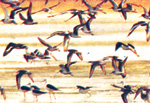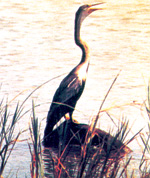| Bundala
National Park
(The Ramsar Wetland )
 Where
else in Sri Lanka could one enjoy viewing Migratory Shorebirds in
their thousands. Bundala National Park an area of 6216ha, located
246 Km South East of Colombo is Sri Lanka’s only Ramsar Wetland,
honored internationally for its significant role since it hosts
over 20,000 shorebirds, at any given time over the period of August
to April. Where
else in Sri Lanka could one enjoy viewing Migratory Shorebirds in
their thousands. Bundala National Park an area of 6216ha, located
246 Km South East of Colombo is Sri Lanka’s only Ramsar Wetland,
honored internationally for its significant role since it hosts
over 20,000 shorebirds, at any given time over the period of August
to April.
This
is a unique area of picturesque lagoons and inter-tidal mud flats
where the wintering birds rest and feed, golden beaches and sand
dunes frequented by nesting sea turtles and the thorny scrub jungle
where elephant, deer and wild buffalo roam. It is also a paradise
for 149 species of resident and migratory birds.
 It
is interesting to note that 45 of these migratory birds are ‘Waders”
associated with the lagoons, tidal mud flats and salterns. Migratory
Stints, Sand Pipers, Plovers, Terns, Gulls, Ducks and Flamingoes,
in their vast numbers, share the same area with the resident water
birds such as Herons, Egrets, Pelicans, Cormorants, Teals, Storks,
Stilts and Grebes and several other species. It would make visitors
to the Park curious about where they come from and why and how they
do so, only during a particular period of the year. It
is interesting to note that 45 of these migratory birds are ‘Waders”
associated with the lagoons, tidal mud flats and salterns. Migratory
Stints, Sand Pipers, Plovers, Terns, Gulls, Ducks and Flamingoes,
in their vast numbers, share the same area with the resident water
birds such as Herons, Egrets, Pelicans, Cormorants, Teals, Storks,
Stilts and Grebes and several other species. It would make visitors
to the Park curious about where they come from and why and how they
do so, only during a particular period of the year.
WHERE
FROM?
These are the birds of Eastern Europe, inhabitants of
the “tundra” of the Siberian region. The Flamingo comes
from Rann of Kutch, of our neighbouring India
WHY?
The Freezing temperatures, snow clad earth and lack of
day light cause a severe shortage of food, forcing these birds to
take an annual journey -”migration” -of thousands of
kilometers southward, braving fatigue, hostile conditions and the
poacher to ensure survival to reproduce.
HOW?
Bird migration is a spectacular event in nature, but still
a mystery. It is believed that the birds “navigate”
during the night, taking their position from the moon and the stars
and during the day time observing the movement of the sun, and also
remembering the prominent and familiar land-marks such as mountains,
rivers, sea coast, valleys etc.
WHEN?
The migration period begins from August with the commencement
of the harsh winter and continues up to mid -April, when the Southern
Hemisphere “attracts” them with plenty of food and sunshine
WHY
VISIT US?
Sri Lanka is the end point of a vast migration of birds
from the North. The birds of Eastern Europe and perhaps, some from
the Western Europe, take the “Indo-Asian Fly Way” one
of the two bird migratory routes in the region, through the Himalayas
and the Southern tip of India to reach Sri Lanka.
Arriving
at the Northern tip of the Island, after a tedious and decisive
journey of thousands of kilometers, the weary shorebirds, take two
routes.
*
One along the North-Eastern coast, through similar habitats such
as Jaffna, Chundikulam and Kokilai lagoons, Arugam Bay and Kumana
group of lagoons, to reach the South- Eastern part of the Island,
Yala, Bundala and Kalametiya.
* The
other the North-Western route, stretching along the sea coast Southward,
via lagoons, tidal mudflats, mangrove swamps of Mannar, Puttalam,
Mundel and the Muthurajawela marsh to reach the South Western sector
of the country
OUR
RESPONSIBILITIES
Lagoons, estuaries, mudflats, mangroves swamps and other wetlands
are the major habitats utilized by the “Winter Visitors”
during their stay with us. Let us therefore Conserve, Protect and
Use these areas WISELY for our enjoyment and to ensure the survival
of our “visitors” and ours, as well. |
 Where
else in Sri Lanka could one enjoy viewing Migratory Shorebirds in
their thousands. Bundala National Park an area of 6216ha, located
246 Km South East of Colombo is Sri Lanka’s only Ramsar Wetland,
honored internationally for its significant role since it hosts
over 20,000 shorebirds, at any given time over the period of August
to April.
Where
else in Sri Lanka could one enjoy viewing Migratory Shorebirds in
their thousands. Bundala National Park an area of 6216ha, located
246 Km South East of Colombo is Sri Lanka’s only Ramsar Wetland,
honored internationally for its significant role since it hosts
over 20,000 shorebirds, at any given time over the period of August
to April. It
is interesting to note that 45 of these migratory birds are ‘Waders”
associated with the lagoons, tidal mud flats and salterns. Migratory
Stints, Sand Pipers, Plovers, Terns, Gulls, Ducks and Flamingoes,
in their vast numbers, share the same area with the resident water
birds such as Herons, Egrets, Pelicans, Cormorants, Teals, Storks,
Stilts and Grebes and several other species. It would make visitors
to the Park curious about where they come from and why and how they
do so, only during a particular period of the year.
It
is interesting to note that 45 of these migratory birds are ‘Waders”
associated with the lagoons, tidal mud flats and salterns. Migratory
Stints, Sand Pipers, Plovers, Terns, Gulls, Ducks and Flamingoes,
in their vast numbers, share the same area with the resident water
birds such as Herons, Egrets, Pelicans, Cormorants, Teals, Storks,
Stilts and Grebes and several other species. It would make visitors
to the Park curious about where they come from and why and how they
do so, only during a particular period of the year.